
From misty mornings to sunlit trails, discover how Monteverde’s unique climate shapes every season—and every adventure.
Imagine standing in a forest where clouds float at eye level, moss carpets the branches like velvet, and the air smells like rain even before it falls. This is Monteverde, Costa Rica—a mountaintop sanctuary suspended between mist and sunlight, where weather isn’t just a condition, but a living part of the experience.
But what is the weather like in Monteverde, really?
Does it rain all the time? Is there a best month to visit? Will you need a raincoat, a sweater… or sunscreen?
Whether you're planning a romantic escape, a family adventure, or a nature-filled journey with friends, understanding Monteverde’s unique climate can make all the difference. Unlike the beaches or lowland jungles of Costa Rica, this cloud forest operates on its own rules—shaped by altitude, wind, and the ever-present dance of clouds.
In this guide, we’ll walk you through:
The science (and wonder) behind Monteverde’s cloud forest weather
What to expect month by month, dry or green
What it feels like to be here in any season
What to pack (and what to leave behind)
And answers to the most common questions travelers ask
By the end, you won’t just know the forecast, you’ll know what it means to live inside the clouds.

(And Why It Matters for the Weather)
If you're trying to understand Monteverde weather, you first need to understand what Monteverde truly is. This isn’t just a mountain town with a view, it’s one of the most celebrated cloud forests in the world. And that makes all the difference.
A cloud forest is a rare and delicate ecosystem that exists only under specific conditions. Think of it as a tropical rainforest that has climbed high into the mountains, so high, in fact, that clouds don’t form above it… they form within it.
Monteverde sits between 1,300 and 1,800 meters (4,200–5,900 feet) above sea level. At this elevation, warm humid air from the Pacific rises, cools rapidly, and condenses into a constant layer of mist and low-hanging clouds. This creates a dreamlike atmosphere where light is diffused, moisture is everywhere, and mosses, orchids, and epiphytes thrive on every surface.
But it’s not just beautiful, it’s climatologically unique.
Unlike the tropical lowlands of Costa Rica, Monteverde’s cloud forest has its own microclimate. It’s cooler, wetter, and often windier. The cloud forest weather can shift dramatically in the span of an hour, sunshine in the morning, a light drizzle by noon, and thick fog rolling in by late afternoon. Yet, this variability is part of what makes Monteverde so rich in biodiversity and unforgettable for visitors.
Here, the weather doesn’t just pass through, it stays. It clings to your jacket, kisses your cheeks, and wraps around the treetops in ways that make time slow down.
Understanding this setting is the key to everything that follows. Because when you know you’re entering a living, breathing cloud, you stop expecting perfect weather, and start expecting wonder.
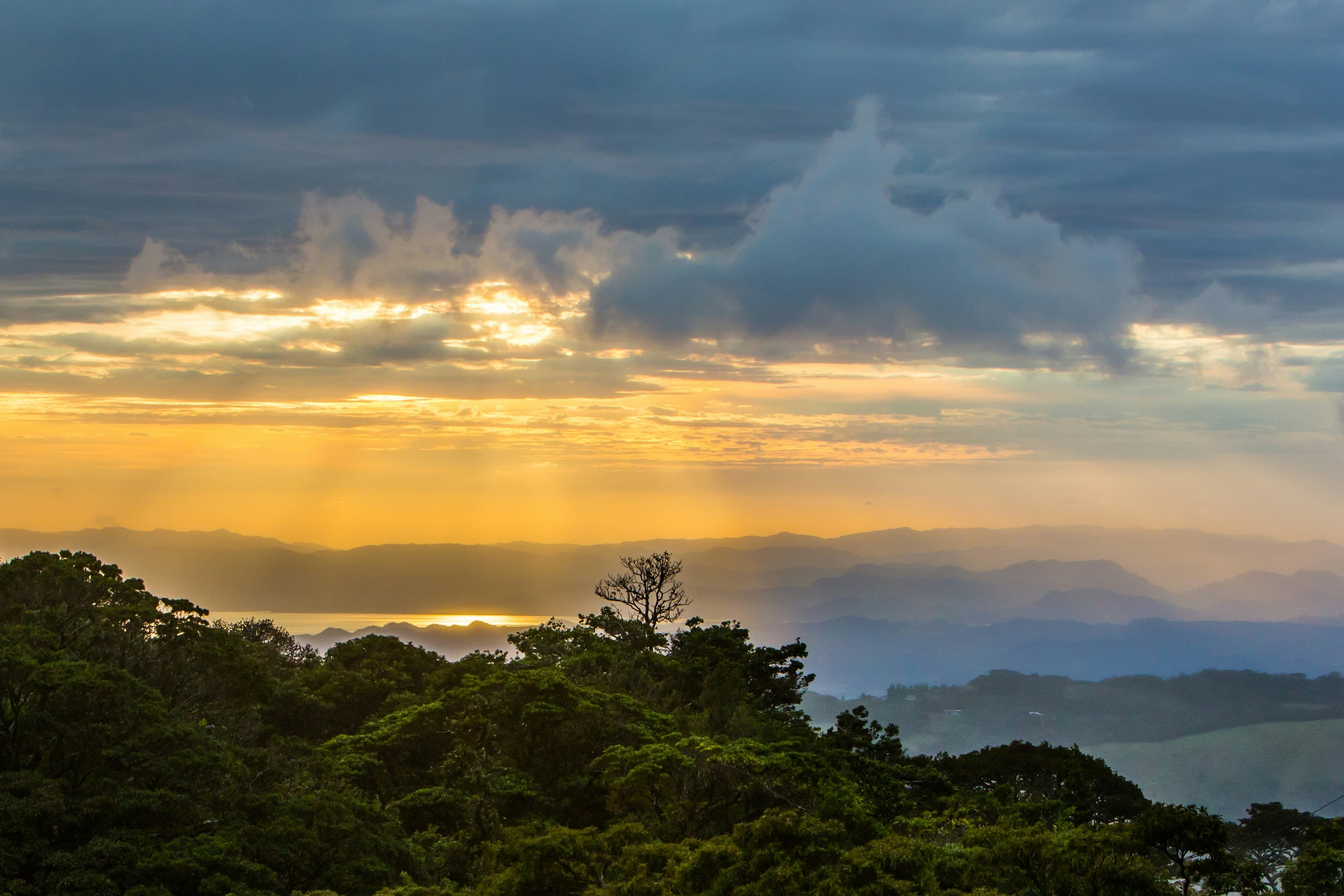
It’s Not Just “Rainy or Sunny”
When people picture Costa Rica’s climate, they often imagine two neat seasons: dry and rainy. But Monteverde weather doesn’t follow such predictable rhythms. Up here in the cloud forest, the climate is shaped by altitude, moisture, and wind in ways that make it feel like a world apart from the beaches or jungles below.
Monteverde has seasons, yes, but not in the traditional sense. Instead of drastic shifts in temperature, changes come in the form of mist, wind, and light. You may hear locals refer to the dry season (roughly December to April) and the green season (May to October), but in truth, these are just general patterns. The real experience is far more nuanced, and more magical.
A key player in this complexity is the trade winds. Blowing in from the northeast during much of the year, these powerful currents sweep through the Tilarán Mountains, bringing not just gusts and cool air, but also horizontal rain and swirling clouds. Sometimes, you'll feel the mist hit your skin sideways, like nature’s own cooling spray.
Then there’s the fog, a soft, drifting presence that can roll in with barely a moment’s notice, blanketing the forest in silence and mystery. And don’t be surprised if a light drizzle starts under blue skies: this is the kind of place where rain and sun often happen at the same time.
Perhaps the most surprising feature of Monteverde’s climate is how much it can change in a single day. A morning hike might begin under golden sunshine, shift to light rain by lunchtime, and end with clouds curling through the canopy as the temperature dips. It’s this unpredictable rhythm that gives the cloud forest its heartbeat, and its soul.
In Monteverde, weather isn’t an inconvenience to work around. It’s part of the adventure. You don’t check the forecast, you embrace the unknown.
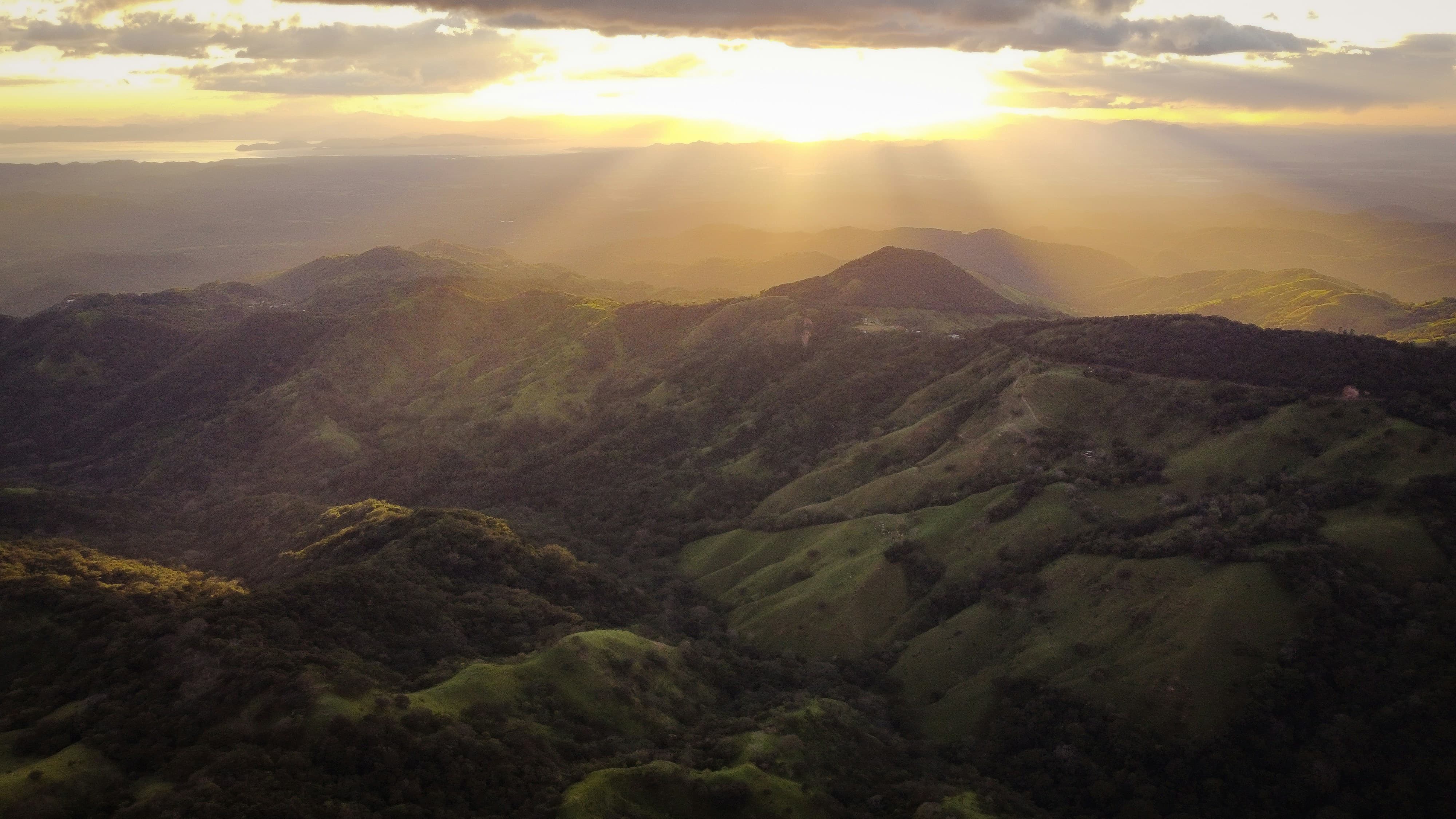
Month-by-Month Highlights
Ask any local guide or hotel owner and they’ll tell you: this is Monteverde’s high season. From December through April, Monteverde enjoys its sunniest, driest months, though, as always in the cloud forest, “dry” is a relative term.
During these months, rain becomes occasional rather than constant, and long stretches of blue skies grace the mornings. The sun filters through the canopy, trails are firmer underfoot, and the sweeping views from lookouts like the Continental Divide are often crystal clear.
But this season brings more than just sunshine, it brings wind.
Lots of it.
Monteverde is known for its strong seasonal winds, especially from late December through February. These gusts can feel exhilarating and refreshing, but also dramatic—rattling windows, howling through the treetops, and turning a simple walk into an elemental experience. Don’t be surprised if a cloud of mist suddenly sweeps across a sunny trail, carried by a blast of air that seems to come from nowhere.
Typical Conditions:
This is also the most popular time for visitors, especially during holiday periods like Christmas, New Year’s, and Easter Week. Wildlife is active, trails are accessible, and Monteverde weather is at its most cooperative for photography, birdwatching, and adventure tours.
Still, don’t leave your rain jacket at home, this is a cloud forest, after all. Even in the dry season, a bit of moisture can always surprise you.

Golden rays cut through the clouds, illuminating Monteverde’s hills — a reminder that even in the dry season, the cloud forest is always alive with shifting light and mist.
If the dry season is Monteverde in its crisp, golden light, then May and early June are when the forest exhales—and everything comes back to life.
After months of sun and wind, the first rains arrive like gentle whispers rather than downpours. They soak the earth slowly, reviving the forest floor and reawakening an explosion of green. The canopy thickens. Orchids bloom. The air smells richer. And the trails, now damp but walkable, take on a softness underfoot that feels deeply grounding.
This is a season of transformation, both in nature and in energy. The big tourist crowds begin to fade, and a quieter, more intimate Monteverde emerges. For many travelers, this is a hidden sweet spot, the best of both worlds: comfortable weather and the first taste of lushness.
Typical Conditions:
· Daytime temperatures: 21–25°C (70–77°F)
· Nighttime temperatures: 13–16°C (55–61°F)
· Humidity: Increasing steadily
· Rain: Light to moderate, often in the afternoons or evenings
· Winds: Less intense, with occasional breezes
You’ll start to see the first full rainbows of the season, usually after a sun-shower that paints the forest in golden mist. And with the rains come more birds, frogs, and insects, a symphony of life reawakening after its brief dormancy.
It’s a time for morning hikes and afternoon hammocks. For sipping coffee as the clouds roll in. For seeing Monteverde in that quiet moment between dry and drenched, when the balance feels just right.
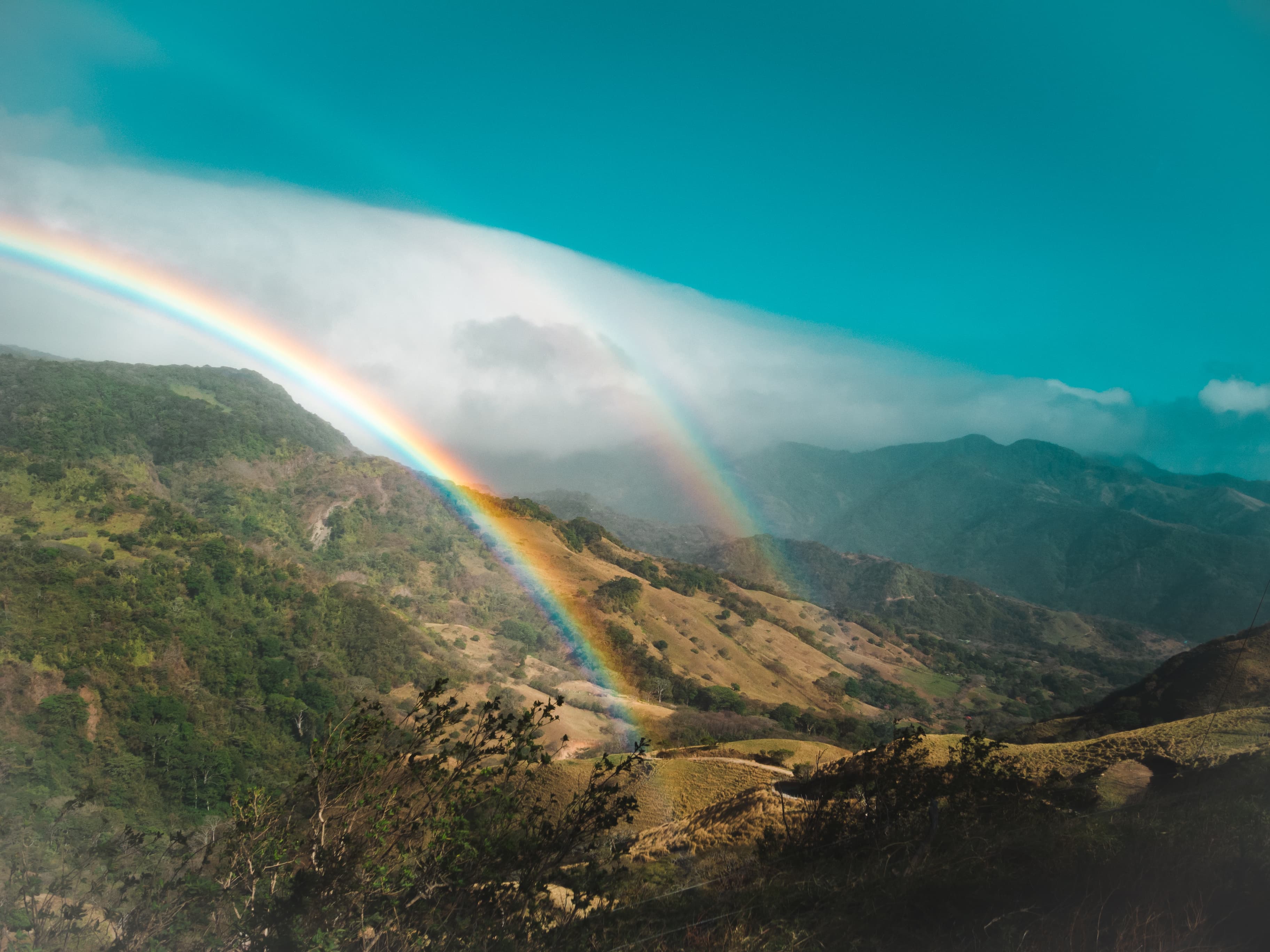
The first rains bring not just moisture, but magic—rainbows like this one arc across Monteverde’s valleys, a vivid sign of the forest waking up.
As the rains settle in and the dry season becomes a memory, Monteverde enters its most misunderstood, and arguably, most enchanting phase: the green season.
From mid-June through August, the cloud forest fully embraces its name. Moisture returns as a constant companion, and everything pulses with life. Trees glisten with dew. Bromeliads overflow. The forest hums, drips, and sings. This is Monteverde weather in its most authentic expression, not always dry, not always predictable, but deeply alive.
What surprises many visitors is that it doesn’t rain all day. Most mornings begin bright and cool, with soft cloud cover and the sounds of birds. It’s usually not until midday or afternoon that the skies open, sometimes with a light mist, sometimes with a tropical downpour. These rains rarely last all night, giving way to peaceful, foggy evenings.
And then there’s July, home to one of Monteverde’s best-kept secrets:
In the middle of the rainy season, a dry spell often appears for 1–2 weeks, usually in early to mid-July. Known locally as El Veranillo de San Juan, this “little summer” brings clearer skies, reduced rainfall, and a sudden return of golden light through the canopy.
It’s an unpredictable phenomenon, some years more pronounced than others, but when it arrives, it feels like a brief reunion with the dry season. Trails dry out, sunset views return, and for the traveler in-the-know, it’s a perfect window of opportunity.
Typical Conditions (mid-June to August):
· Daytime temperatures: 20–24°C (68–75°F)
· Nighttime temperatures: 13–16°C (55–61°F)
· Humidity: High and steady
· Rain: Moderate to heavy, mostly in the afternoons
· Mornings: Often dry, misty, and magical
· Veranillo: Drier pocket in early/mid July (varies each year)
Far from being a reason to avoid Monteverde, this season is a reason to fall in love with it. The forest is lush, uncrowded, and in full expression. Trails may be muddy, but they're quiet. Wildlife sightings increase. And when the fog rolls in during an afternoon hike, it feels like walking through a dream.
By the time September and October arrive, Monteverde is deep in its rainy rhythm. These are the wettest months of the year, and for many travelers, that might sound like a warning. But to others—photographers, writers, wildlife lovers—this is when the cloud forest bares its soul.
Yes, it rains. Often.
And sometimes, it pours.
But within that moisture lies a raw, almost mystical beauty that you won’t find any other time of year.
Mornings can still surprise you with golden light and still air, perfect for a short hike, a zipline run, or early birdwatching. But as midday approaches, the skies shift. Afternoon rains become a near-daily presence, sometimes arriving in waves, sometimes in heavy mists that feel like walking through breath itself.
Trails may be muddy and certain rural roads more difficult to access, but Monteverde itself remains open, alive, and deeply welcoming. Tourism slows down, meaning more space, more silence, and more intimacy with the forest.
Typical Conditions:
· Daytime temperatures: 19–23°C (66–73°F)
· Nighttime temperatures: 13–15°C (55–59°F)
· Humidity: High, often near saturation
· Rain: Frequent and heavy, especially in afternoons and evenings
· Fog: Common and persistent at higher elevations
· Trails: Slippery and damp—good shoes are essential
But here’s the secret:
This is the time when Monteverde is at its greenest, its quietest, and its most photogenic. The contrasts between mist and moss, orchids and cloud, sunlight and shadow, it’s a visual and emotional experience that defies the idea of "bad weather."
So if you're the kind of traveler who doesn’t mind getting a little wet, or even craves that poetic, moody ambiance, September and October might just be your season.
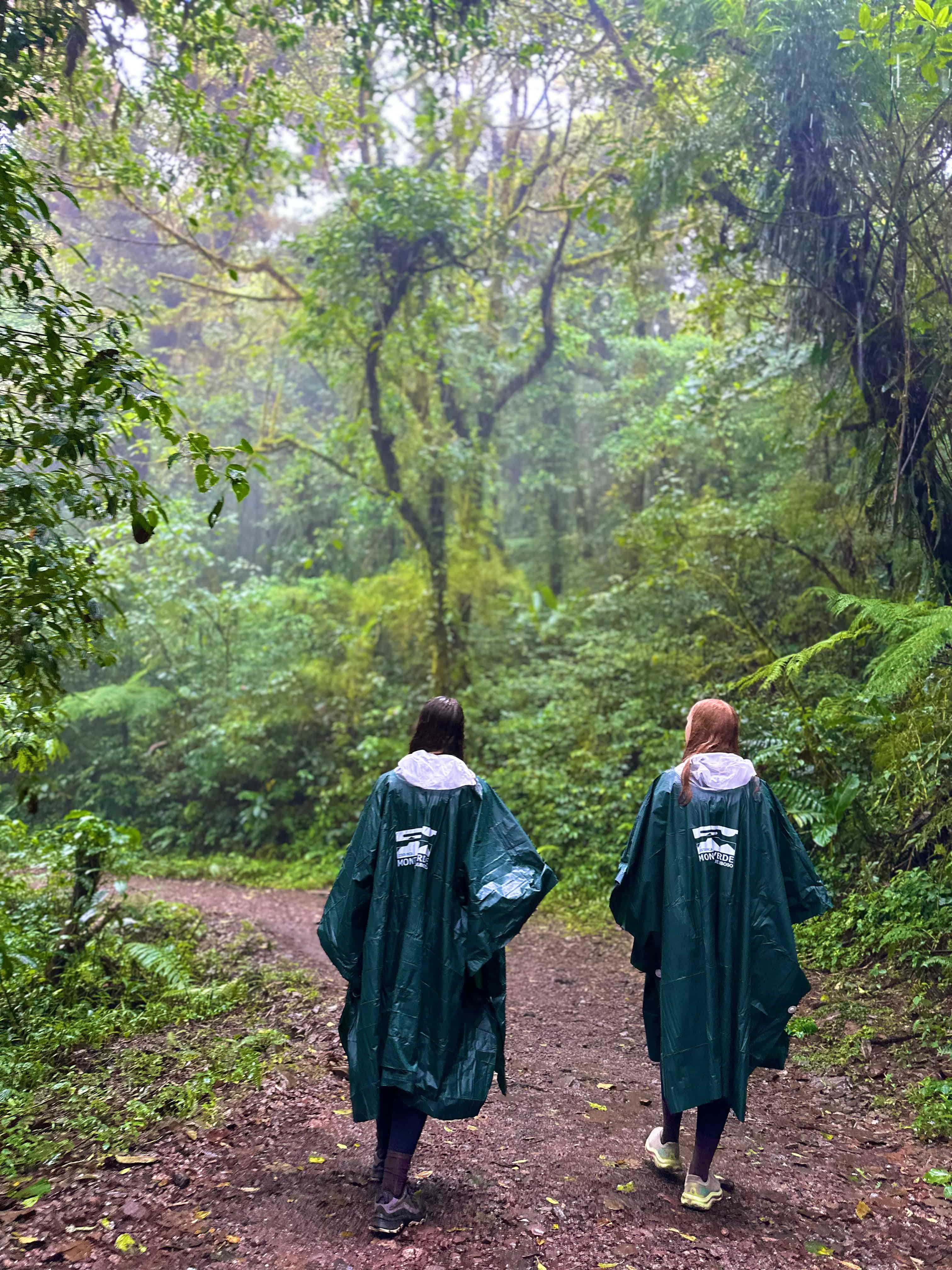
Ponchos become your best friends on hikes like this, as light rains and mist weave through the forest — not an inconvenience, but an invitation to slow down and feel Monteverde’s green season all around you.
November – Wind, Mist, and a Taste of Change
November is the month when Monteverde begins to shift once more. The rains don’t vanish overnight, but they soften. The skies begin to clear. The forest exhales again, this time not in moisture, but in movement.
The first real sign of change is the wind.
By mid-November, gusts start to dance through the treetops, sweeping away lingering clouds and pushing moisture out to sea. The air becomes cooler, crisper, and drier (though light rains and mists still make regular appearances), especially in the early part of the month.
This is a time of contrast. You might wake to a misty, mysterious morning, then find yourself basking in sunshine by mid-afternoon. Trails begin to dry out. Orchids drop their last blossoms. The birds, especially migratory species, grow more active. It’s as if the entire forest is stretching its limbs, preparing for the brightness ahead.
Typical Conditions:
Daytime temperatures: 21–25°C (70–77°F)
Nighttime temperatures: 13–16°C (55–61°F)
Humidity: Moderately high, but decreasing
Rain: Light to moderate, tapering off by late month
Winds: Increasing steadily, especially late November
Skies: Mixed; clearer days become more common
Tourism begins to pick up again as travelers look to beat the December crowds, making November a strategic sweet spot: better weather, fewer people, and lower prices.
If you visit Monteverde in November, you'll feel the pulse of change, not just in the weather, but in the energy of the place. It’s a time of subtle drama, of shifting skies, of light returning through the clouds.
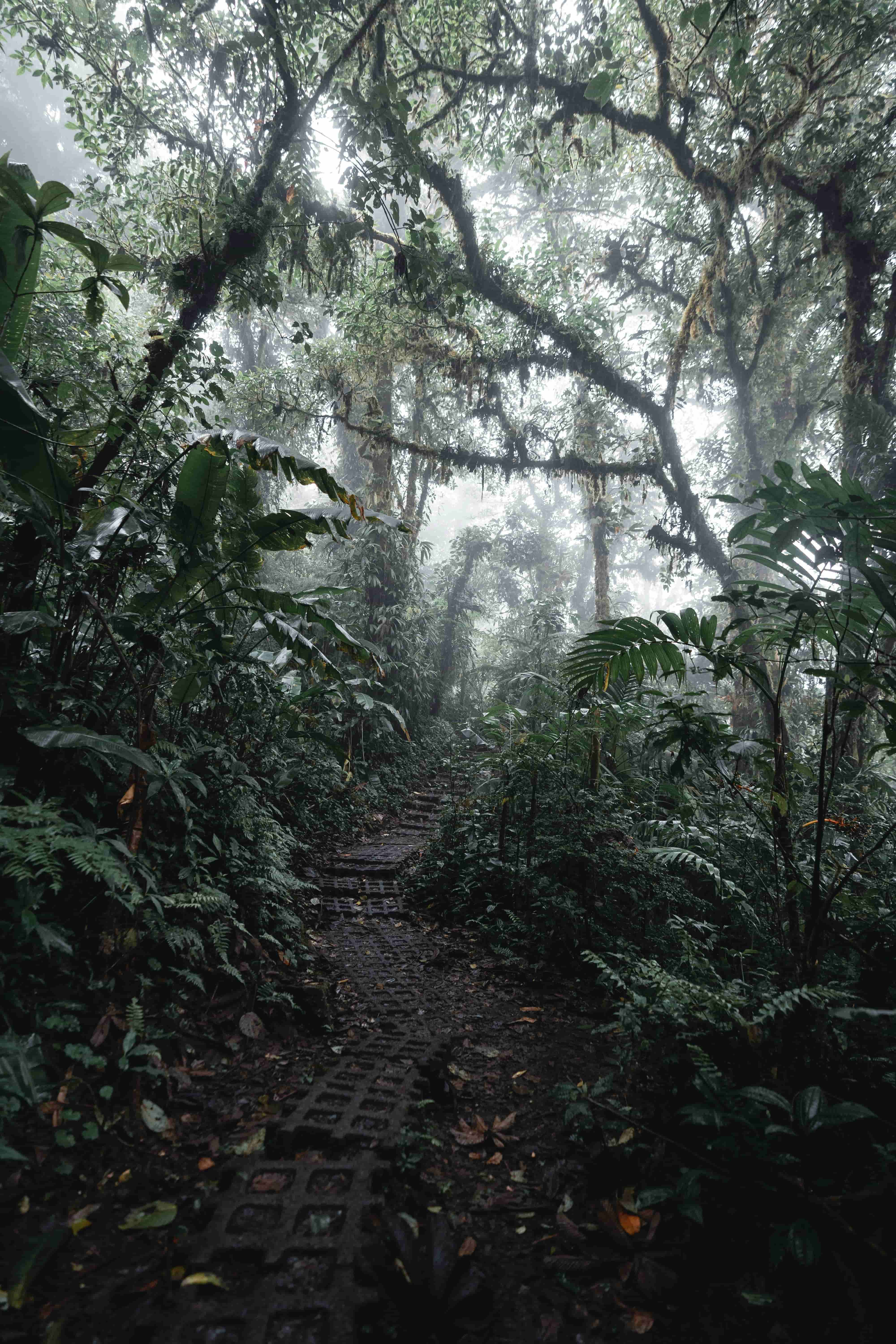
On trails like this, November feels alive with change — the mist hangs in the air, but the wind whispers that clearer skies are coming.
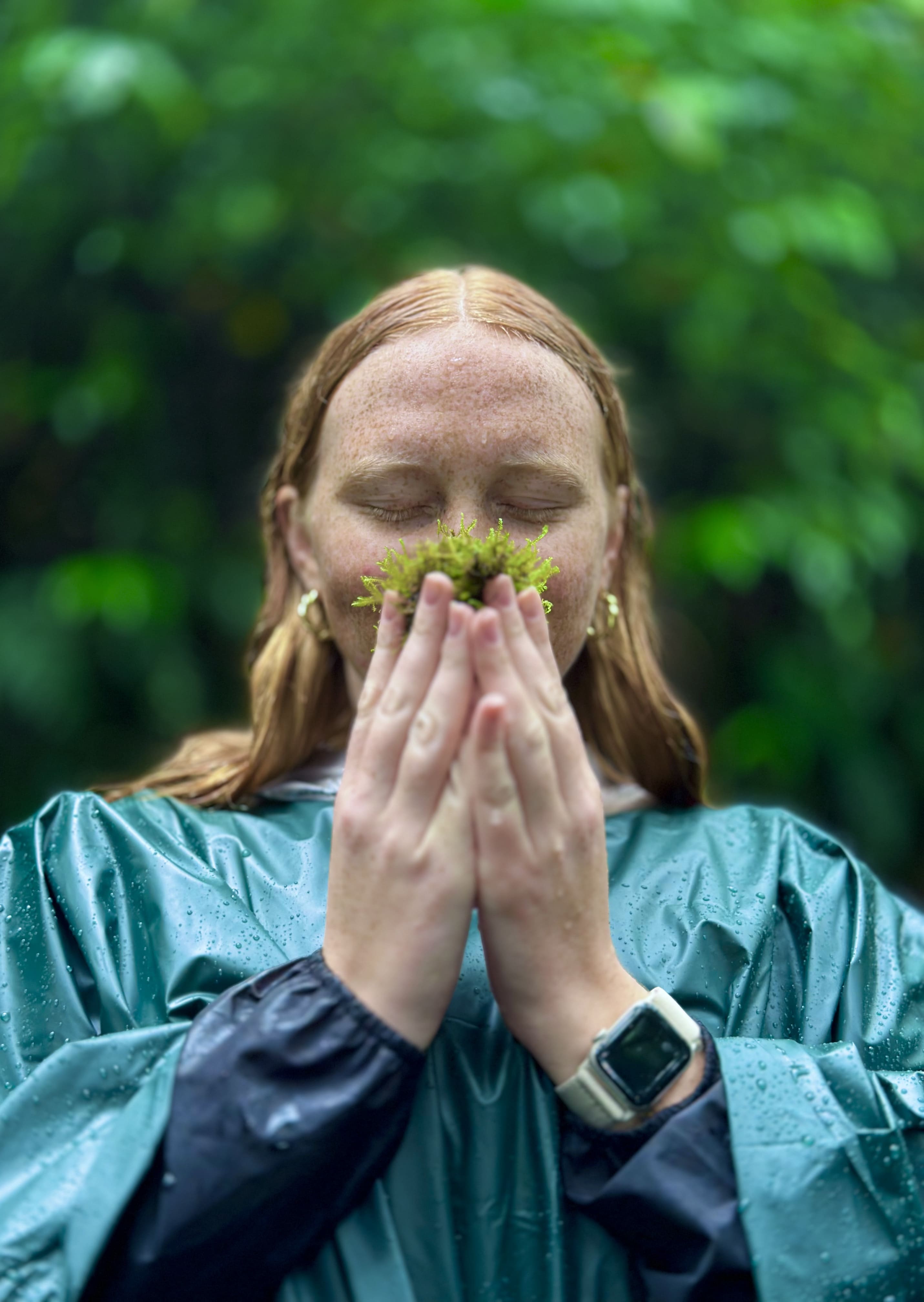
(Not Just What the Numbers Say)
You can read the numbers... You can check the forecast... But nothing truly prepares you for what Monteverde weather feels like, because this isn’t a place you observe from a distance. It’s a place that touches you.
Step outside in the morning and you might find yourself wrapped in a fine mist that drifts through the trees like silk. Clouds curl through the forest not above, but around you, soft and slow, like breath. The air is cool but never biting, moist but not heavy. It carries the scent of moss, earth, and orchids. You’ll hear leaves rustling in the wind, the distant call of a quetzal, or the soft tap of a raindrop falling from leaf to leaf. It’s not weather, it’s presence.
During the day, temperatures remain comfortable and walkable. You might start a hike in a light fleece and end it in a T-shirt. By night, though, Monteverde changes. The forest gets quiet. The wind picks up. Temperatures drop sharply, and you’ll want a jacket or sweater, especially if you're staying in the higher elevations.
The wind deserves a story of its own. At times, it’s gentle, like a sigh through the branches. Other times, it roars through the mountaintops, rattling rooftops and singing through the trees. It’s not uncommon to feel a gust that quite literally moves you. And in those moments, you understand: this forest is not just alive, it’s awake.
But perhaps the most powerful feeling comes from unpredictability. Here, the weather doesn’t follow your itinerary, and that’s part of the wonder. You learn to embrace it. To slow down. To watch the clouds roll by instead of checking your phone. To let nature decide the pace.
Monteverde’s weather is not about perfection, it’s about immersion. It doesn’t just shape your trip.
It becomes the memory.

(And What Not To)
Packing for Monteverde is less about fashion and more about function, and the key word is layers.
The cloud forest doesn’t have extreme heat or cold, but it does have variety. A single day might take you from sunny skies to misty trails to cool, windy evenings. And if you're not prepared, you might find yourself soaked, chilly, or just plain uncomfortable. But don’t worry—we’ve got you covered.
These are must-haves no matter when you visit:
Light waterproof jacket – not just water-resistant; go for a true rain shell with a hood
Quick-dry clothing – synthetic or moisture-wicking fabrics are your best friend
Light fleece or thermal layer – especially for evenings and early mornings
Hiking shoes or boots with grip – trails can be muddy and slippery year-round
Daypack with rain cover – for excursions, snacks, and layering gear
Reusable water bottle – hydration matters at altitude
Flashlight or headlamp – power outages aren’t common, but they do happen
Bug repellent – especially in lower elevations or after rain
Sun protection – sunscreen, sunglasses, and a hat (yes, even in a cloud forest)
If you’re visiting during the green season (May–October), consider packing:
If you’re visiting during the dry season (Dec–April):

Some things are better left out of your suitcase:
Umbrellas – charming in cities, but useless here with the wind
Open sandals or flip-flops – fine around your hotel, but impractical for the terrain
Heavy winter coats – too warm and bulky; layering works better
Jeans – once wet, they stay wet. Not ideal for hiking or sudden rain
Large rolling suitcases – Monteverde’s roads and sidewalks favor backpacks or duffels
Pro tip:
Monteverde may be remote, but it’s not isolated. If you forget something, there are outdoor shops and mini-markets in town. Still, it’s better to arrive prepared and spend your time exploring—not shopping.
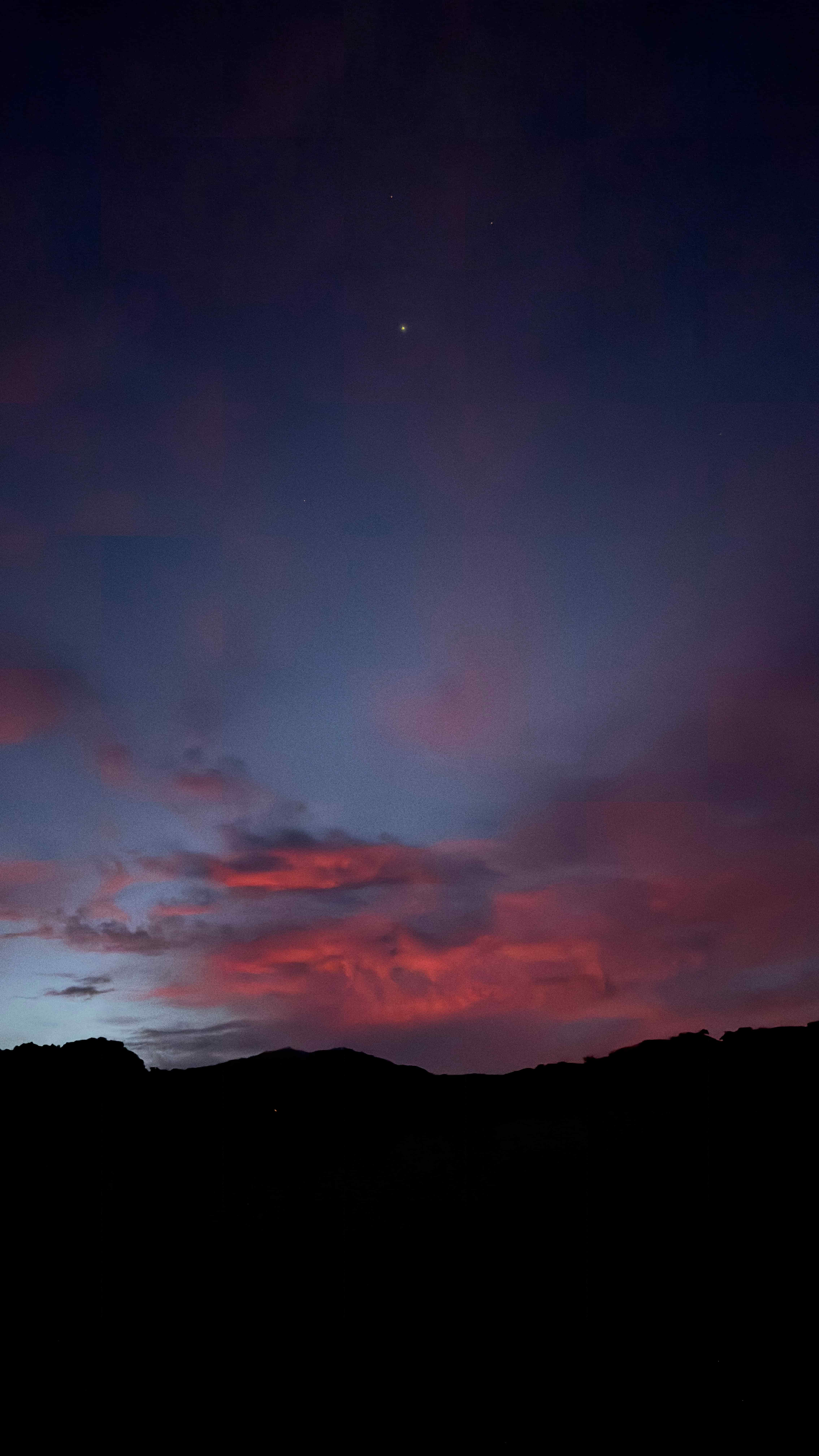
Practical answers to the most common climate questions about Monteverde
Not exactly. Even during the green season, Monteverde typically starts the day with clear or cloudy skies, followed by rain in the afternoon or evening. During the dry season (Dec–Apr), rain is rare, but the cloud forest is never bone-dry. Mist, fog, or light drizzle can appear any time, especially in the higher elevations. It’s part of the magic.
Yes, by tropical standards. Nighttime temperatures usually drop to 13–16°C (55–61°F). That might not sound freezing, but the humidity and wind can make it feel colder. A sweater or light jacket is a must, especially if your accommodation is at higher altitude or has open-air design.
There’s no single “best” month, it depends on what kind of experience you want: • December to April: Sunny, windy, dry trails, busiest time • May to mid-June: Lush and blooming, fewer tourists • July: Surprise dry spell (El Veranillo) within the green season • Sept–Oct: Quiet, wet, intensely green and introspective • November: Transition month—less rain, more light, fewer crowds If you want ideal weather, go between Jan–Mar. If you want fewer people and a greener forest, May or November might be your month.
Absolutely, just go early and be prepared. Most rain falls in the afternoon, so morning hikes are ideal. Trails can be muddy, but still accessible. Wear sturdy waterproof footwear, carry a poncho or rain jacket, and embrace the experience. Seeing the forest in the rain—mist rising, leaves glistening—is unforgettable.
Rarely. Monteverde’s tours are built around the climate, not against it. Guides know how to adjust routes and timing. Canopy tours, night hikes, and even ziplines usually run rain or shine, unless there’s severe wind or lightning, which is uncommon. In fact, many say the forest is even more alive during light rain. Just dress appropriately, and you’ll still have a great time.
Yes, and it’s one of the most iconic parts of the experience. Fog is simply a cloud at ground level, and in a cloud forest, that’s expected. It can roll in quickly and vanish just as fast, creating an almost surreal atmosphere. Far from a nuisance, it’s part of the soul of Monteverde.
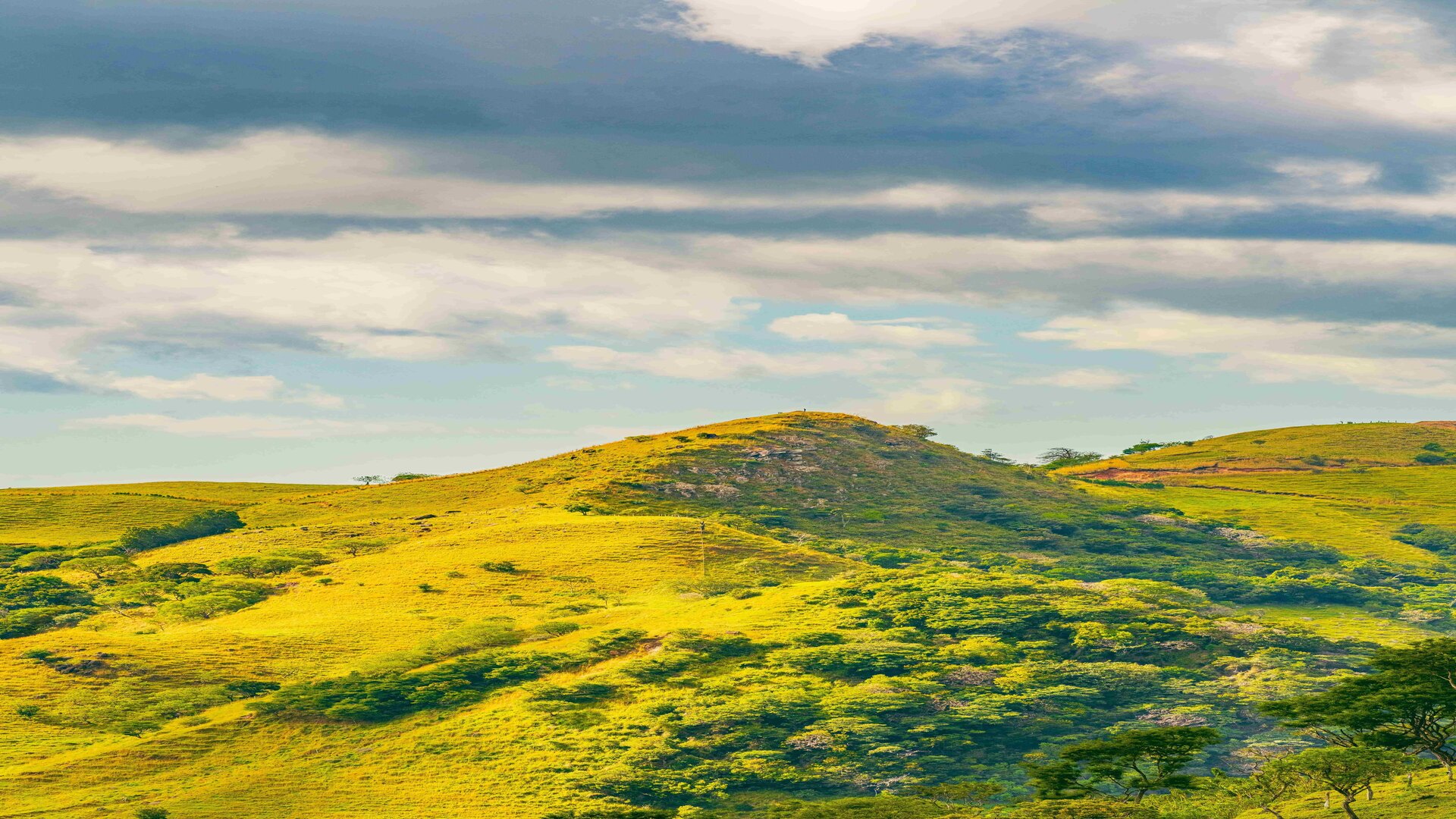
Let the Weather Be Part of the Magic
You’re stepping into an ecosystem that breathes, moves, and surprises.
The weather here is not a challenge to avoid. It’s a dimension to explore.
It’s what makes the air smell like orchids.
It’s what paints the forest in silver and green.
It’s what gives every trail, every lookout, every moment a different shade of wonder.
So instead of chasing perfect skies, chase authentic experience.
Come prepared. Come curious.
And let the shifting winds, soft rains, and rolling clouds become part of your story.
Because in Monteverde, the weather isn’t just part of the journey—
It’s part of what makes it unforgettable.
Now that you understand the seasons, use our Activity Finder to find the perfect tour any time of year.